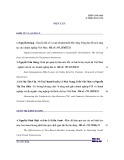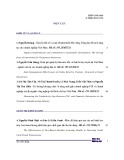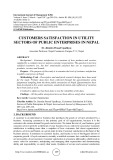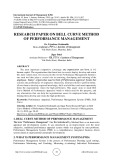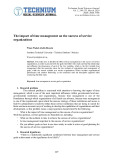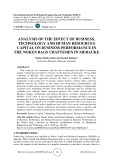
VNU Journal of Economics and Business, Vol. 4, No. 6 (2024) 43-51
43
Original Article
Locational and firm-level determinants of total factor
productivity in Vietnamese manufacturing
Dong Thanh Mai1, Dao Viet Anh2, Shah Fahad3,
To The Nguyen2* Vu Hoang Linh2
1Vietnam National University of Agriculture
Trau Quy, Gia Lam, Hanoi, Vietnam
2VNU University of Economics and Business
No. 144 Xuan Thuy Road, Cau Giay District, Hanoi, Vietnam
3Business School - University of Jinan
No. 601, Huangpu Avenue West, Tianhe District, Guangzhou, China
Received: October 09, 2024
Revised: December 06, 2024; Accepted: December 25, 2024*
Abstract: Total factor productivity (TFP) has received much attention from both academics and
policy makers in the past decade, as it promises an answer to the question of sustainable growth in
the context of limited inputs. This article examines the TFP of manufacturing companies in
Vietnam and the factors at the firm level, in addition to locational drivers, especially at the
provincial level, that drive the change in TFP. We use a strongly balanced panel dataset of 1,130
manufacturing firms from 2014 to 2018 and the Wooldridge method to calculate the TFP and a
general least squares estimator with a heteroskedastic and uncorrelated error structure to examine
the determinants. The results show that the TFP of firms is driven by factors at both the firm and
the province levels. Specifically, firm size and capital intensity have a positive impact on TFP,
while differences in firm type also influence TFP outcomes. Furthermore, six locational factors
significantly impact firms’ TFP, with a particular emphasis on Information and Communications
Technology (ICT) readiness, transparency index, and corruption index. Most importantly, we
found that transparency and corruption have a nonlinear inverse U-shaped association with the
TFP of firms, implying that there is an optimal midpoint of governance quality that maximizes the
TFP of firms. The article then provides certain implications for both policymakers and firms in
improving their TFP.
Keywords: Total factor productivity, manufacturing, Vietnam.
________
* Corresponding author
E-mail address: tothenguyen@vnu.edu.vn
https://doi.org/10.57110/vnu-jeb.v4i6.273
Copyright © 2024 The author(s)
Licensing: This article is published under a CC BY-NC 4.0 license.
Copyright © 2024 The author(s)
Licensing: This article is published under a CC BY-NC 4.0 license.
VNU Journal of Economics and Business
Journal homepage: https://jeb.ueb.edu.vn

VNU Journal of Economics and Business, Vol. 4, No. 6 (2024) 43-51
44
1. Introduction
The question of how to increase and
maintain sustainable economic growth has been
the focus of economists and policy makers for a
long time. Within this scope, the TFP has
occupied a large volume of literature. Previous
studies have measured and evaluated TFP from
various angles. In different countries, TFP was
also found to contribute significantly to
economic growth (Arazmuradov et al., 2014;
Park, 2012).
Due to the significant share of the
cumulative growth process, studies on the
composition of TFP have gradually emerged.
Specifically, several determinants that have an
impact on, or are at least associated with TFP
growth, closely follow the orientation of two
main branches, which are internal and external
factors. The latter then includes integration and
invariant; and competition, social dimension,
and environment. Some studies stated that TFP
depends on technological change and intangible
factors such as the allocation of resources, the
diligence of workers, and the management skills
or process regulation of governments which were
parts of “economic restructuring, economic
recovery, and government involvement”
(Mankiw et al., 1992). Furthermore, the channel
to convert and improve knowledge and
technology is always one of the most effective
direct factors that have the greatest direct
impact on TFP.
Vietnam is a developing country with an
economy that formerly relied on input-intensive
sectors such as agriculture. However, to ensure
high and sustained growth, the Vietnamese
government has shifted its focus towards
productivity. Furthermore, the need to enhance
TFP and productivity in general is more evident
when the economy deals with negative
externalities such as the recent COVID-19
epidemic. While the world economy experienced
a slump in growth, the Vietnamese economy
grew by 2.91% in 2020 (GSO, 2020) in which
the processing and manufacturing industry
played a key role in creating the most added
value for the industrial sector and is the main
driving force behind the country’s continued
economic growth. In the last decade, the Red
River Delta region has received various key
public investments. This is also the period that
the region experienced a high growth rate.
Given that, the Vietnamese government often
ascribes this growth to the right investment
policy or other institutional factors. This can be
partly justified since top-down investments
mainly focus on changing the characteristics of
the business environment rather than changing
the firms themselves. However, to our
knowledge, the current literature has not seen
any reliable empirical studies on the effect of
locational and institutional effects on TFP in
Vietnam. Therefore, this study aims to fill this
gap by examining TFP and its drivers among
manufacturing firms in the Red River Delta in
North Vietnam.
2. Literature review and hypotheses
Locational factors can be considered
equivalent to the aspect of location-specific
advantages in which investors must consider
aspects of the local environment to invest to
maximize return. Cuervo-Cazurra et al. (2014)
defined location-specific advantages as the
advantage that firms in a certain geographical
space have over firms in other locations. Firms
benefit from their geographic location because
they have access to resources that firms in other
places do not. In that concept, it may include
access to skilled labor, incentives, market
premiums, access to growing markets, superior
infrastructure, and cost savings.
Specifically, according to Lewin and
Volberda (1999), the interaction of two unique
types of co-evolutionary processes, emergent
and guided, is best understood as the process of
creating a location advantage. This view is a
combination of micro- and macro-problems in a
unified framework at each process that is
emergence and direction. This combination of
multiple levels of extensive parallel analysis
leaves room for new and random effects to
emerge. Accordingly, local advantages are
divided into two types including location
savings and other local market features.
Location savings arise from cost savings due to
differences in the cost of operations, such as
labor costs, real estate costs, information costs,
or time costs. Other market features can be
considered as local market attributes such as

D.T. Mai et al. / VNU Journal of Economics and Business, Vol. 4, No. 6 (2024) 43-51
45
purchasing power and preferences of indigenous
people in the market. Regional growth causes
an increase in demand for goods and products,
affecting the level of competition in the market.
Based on regional differences, firms can take
advantage of regional characteristics to remain
competitive and develop.
The component in investigating the
determinants of the TFP of a company can be
mentioned as a location-specific advantage,
such as the regional environment of a company.
Empirical studies have discovered that fiscal
decentralization has a significant impact on TFP
growth through transmission channels such as
public sector efficiency (Adam et al., 2014),
public capital investment (Destefanis & Sena,
2005), and local institutional environment (Song
et al., 2018). In Vietnam, PCI is an index
commonly used to assess the environment in
provinces. Most of the research has examined
how the quality of the environment of a
province affects the TFP of a company. Some
studies find developed capital markets (La Porta
et al., 1997), a network of competitive firms
(Gulati et al., 2000), or supporting institutions
(Peng et al., 2008) and good regulations
(Djankov et al., 2002) as location-specific
advantages for firm’s operation.
Concerning ownership, Barbera (2011)
examines the relationship between firm
ownership and productivity and shows that
family labor and capital produce a wide range
of production contributions when compared to
nonfamily equivalents. In particular, family
labor output contributions are much higher,
whereas family capital output contributions are
significantly lower. Interestingly, differences in
TFP between family and nonfamily firms
disappear when allowing for heterogeneous
output contributions of family production
inputs. In addition, there have been a number of
studies conducted on the type of ownership
such as Dvoulet and Blaková (2021). Driffield
and Du (2007) show that the TFP growth of a
corporation is reduced when it is transferred to
state control. On the other hand, switching
ownership to alternative types does not have a
statistically significant effect on output.
Moreover, Griffith et al. (2003)
concentrated on two processes by which foreign
FDI can influence the level or rate of domestic
productivity growth. They discover that foreign
companies, as well as other high-productivity
domestic companies, play a role in the
convergence process. In addition to FDI, in
technology transfer, ICT is also considered a
constant breakthrough. Recently, ICT has played
an important role in different aspects of human
life.
3. Data and research methodology
3.1. Data
This study aggregated the firms’
characteristics data based on the firms’ financial
statements from the Vietnam Enterprises
Survey (VES) of the General Statistics Office
(GSO) and the Provincial Competitiveness
Index (PCI) for variables related to provincial
specific advantages. The final data set includes
1,130 manufacturing companies in the 5 years
2014 to 2018. Furthermore, to assess the
willingness to apply information technology,
this study also applies the ICT index classified
by province and extracted. The companies are
located in 10 provinces of the Red River Delta
including Ha-Noi, Hai-Phong, Ninh-Binh,
Nam-Dinh, Thai-Binh, Vinh-Phuc, Hai-Duong,
Hung-Yen, Bac-Ninh, and Ha-Nam.
Among 1,130 firm-level observations, the
average number of laborers is 679. The average
value of capital per employee is 1.4 billion VND.
Among 225 firms in 5 years, an average studied
firm has an annual profit of about 49 billion
VND while the average profit margin is 4.7%
and ROA is 18.7%. We use the number of
laborers to classify firms into 4 levels of firm
size, of which 63 are very small firms: 342 are
small firms, 190 are medium firms, and the
remaining 535 are large firms. There are three
types of firm ownership, namely state-owned,
foreign-owned, and private-owned. In terms of
the ICT readiness index of provinces, most
provinces during the study period have a low or
medium level of ICT. There are two important
variables that reflect a province’s level of
governance, namely transparency and

D.T. Mai et al. / VNU Journal of Economics and Business, Vol. 4, No. 6 (2024) 43-51
46
corruption. The former is a subindex from the
PCI database that assesses the province's ability
to be transparent about its public agenda. The
higher this index, the easier it is for a
province’s constituents to update and
understand the governing actions and to adjust
their response accordingly. During the research
period, Vinh-Phuc is the most transparent
province with an average index of 6.678. For the
latter variable, corruption is proxied by another
subindex named “informal cost” that reflects
additional fees a firm needs to pay to maintain its
business operations. The higher the informal
charges, the more likely the governmental
authority is to be corrupt. Ninh-Binh is on
average the most corrupt province with the
informal costs index at 5.84, followed by Vinh-
Phuc at 5.824.
Table 1: Statistical description and definition of variables
Variable
Description
Mean
Std.Dev.
Min
Max
Firm level
TFP
TFP of firm
1.415
3.619
0.001
100.070
Labor
Number of employees (people)
684.030
1,867.709
2
23,353
Capital
Total asset (million VND)
519,487.4
1,163,339
453.7
1.44e+07
Profit
Firm profit after tax (million VND)
50,190
124,506.8
2
1,095,136
Cost
Cost of goods sold (million VND)
1,015,248
3,733,249
57.1
6.72e+07
K-L
Assets-to-employment ratio (million VND/person)
1,397.087
2,165.674
2.593
26,681.51
ROA
Return on asset (%)
0.185
3.606
0.60e-4
121.239
Margin
Profit margin (%)
0.048
0.074
0.60e-4
0.974
FirmT
Firm type (dummy variable, 3 levels)
2.365
0.532
1
3
FirmS
Firm size (dummy variable, 4 levels)
3.059
0.998
1
4
Locational level
Trans
Transparency index in public governance
6.033
0.401
4.88
7.11
Corrup
Informal costs as a proxy for corruption
5.026
0.623
4.21
6.97
ICT
Information and communication technology
readiness (dummy variable, 3 levels)
1.472
0.737
1
3
FDIat
Provinces give priority to FDI
attraction than private sector development (% agree)
51.128
7.504
33
65
HumaRes
Percent of workers completed training
at vocational schools or higher (%)
45.483
7.100
33.66
67.79
Population
Total population (people)
3,432,085
2,848,459
802,700
7,520,700
GDP
GDP per capita (million VND/person)
81.433
34.680
22.931
150.083
Unemployment
Unemployment rate (%)
2.072
0.007
0.55
3.9
Source: Authors.
3.2. TFP measurement method
Consider a Cobb-Douglas technology for
firm i at time t:
Y
it
= A
it
K
itα
L
it
(1)
where Y
it
is the output of firm i at the
period t, A
it
, K
it
, L
it
are respectively TFP,
capital and labor of firm i at period t.
Taking a logarithm of the Equation (1),
we have
lnY
it
= lnA
it
+ β
k
lnK
it
+ β
l
lnL
it z
(2)
Suppose: ln A
it
= β
0
+ ε
it
and y
it
= ln Y
it
, k
it
= ln K
it
, l
it
= ln L
it
, we have:
y
it
= β
0
+ β
k
k
it
+ β
l
l
it
+ ε
it
(
3)
where: β0 is mean productivity level over time.
εit is the time and firm-specific deviation from
the mean. At a particular deviation at time t, it
can be decomposed into the predictable
component vit and unobservable component uit.
The latter is idiosyncratic output shock and can
be referred to as white noise.
y
it
= β
0
+ β
k
k
it
+ β
l
l
it
+ v
it
+ u
it
(4)

D.T. Mai et al. / VNU Journal of Economics and Business, Vol. 4, No. 6 (2024) 43-51
47
with wit = β0 + vit represents firm-level
productivity, and normally, firm productivity is
calculated as follows:
(5)
finally, TFP or productivity in levels will be the
exponential of ŵit.
This study applies a method of instrumental
variables estimator as formulated by Wooldridge
(2009) and Petrin and Levinsohn (2012) (LP).
These methods propose the solution for the
simultaneity issue by using the proxy for
unobserved productivity shock
uˆ
i t
.
In addition,
this study uses a semi-parametric approach to
LP estimation that includes a proxy of
intermediate inputs rather than investment to
overcome the simultaneity bias issue suggested
by Wooldridge (2009) in adopting the
generalized method of moments (GMM). In
particular, he shows how to write the relevant
moment restrictions in terms of two equations:
these have the same dependent variable (yit) but
are characterized by a different set of
instruments.
The Cobb-Douglas production function for
firm i is given as:
v
it
= β
0
+ β
l
l
it
+ β
k
k
it
+ ω
it
+ ε
it
(6)
in which: vit is the log of value added, lit is
the log of number of laborers and kit is the log
of the capital stock. The error term is separated
into ωit which represents the unobserved
productivity of the firm, and εit which captures
both the measurement error of value added and
unpredictable shocks.
3.3. Model specification
On the basis of an overview of theories,
models, and related studies to evaluate the
impacts of determinants on the TFP of firms the
study proposes a research model of the impact
research at the firm’s characteristics level and
provincial level as follow:
y
ijt
= γ
t
+ α
X
ijt
+ β
Z
jt
+
u
j
+
e
ij
(7)
where
y
ijt
is the TFP of the firm i located in
province
j
at time t, γ
t
is the mean TFP across
all firms and all provinces at time t. X
represents a vector of firm-level variables, Z
presents the variables at the province level.
4. Results and discussion
4.1. TFP in the Red River Delta
Figure 1a illustrates the average TFP in the
period 2014 to 2018. As shown in the figure,
TFP in the Red River Delta has gradually
increased. Higher TFP shows a more efficient
use of inputs among manufacturing firms.
Figure 1b describes the heterogeneity of
TFP among 3 types of business ownership:
SOE, Private and Foreign. The average TFP
in foreign-owned firms is always higher than
the other types. That reflects that the type has
greater technological improvement and does
not depend on the intensive use of labor and
capital compared to the other two types.
Private enterprise has the lowest average TFP
among the three types. However, the gap
between private firm’s TFP and others has
narrowed over time. In 2018, private firms
even outperformed state-owned firms in terms
of TFP.
Figure 1c presents the changes in TFP
among 4 types of firm sizes. While very small
and large firms did not experience many
changes in their TFP, the figures of small and
medium firms show an upward movement.
During the studied period, small companies
gradually increased their TFP, from around 0.6
in 2014 to more than 1.4 in 2018. On the other
hand, most of the changes in the TFP of
medium firms happened between 2017 and
2018. Before 2018, the bigger firms tend to
have a higher TFP. But due to the dramatic
change in medium-sized companies in 2018,
this group surpassed large companies and
emerged on top of the TFP placement.
As shown in Table 2, the gap between the
provinces in terms of average TFP is quite large.
The highest TFP is 2.369 from Bac-Ninh, and
the lowest TFP is 0.156 from Nam-Dinh.
Furthermore, the standard deviations of the TFP
distribution in some provinces such as Bac-
Ninh, Ha-Noi, Hai-Duong, and Hai-Phong are
larger than in others, indicating that the
difference between firms in these provinces is
considerable.


